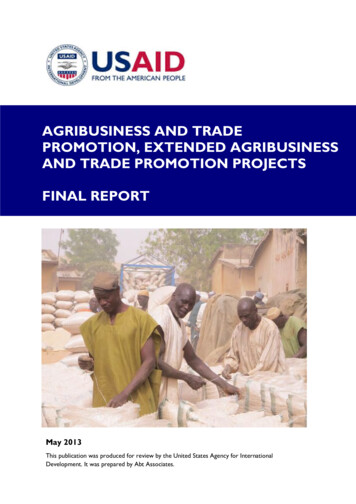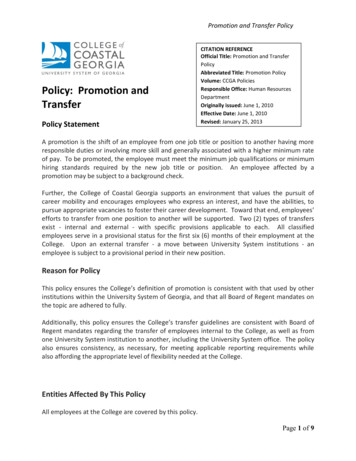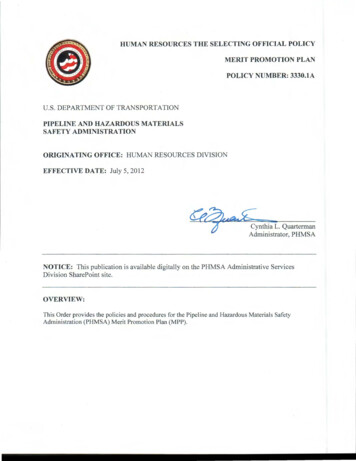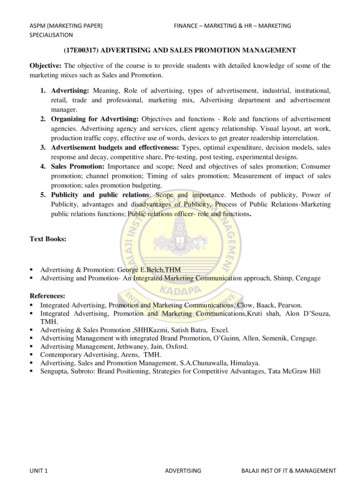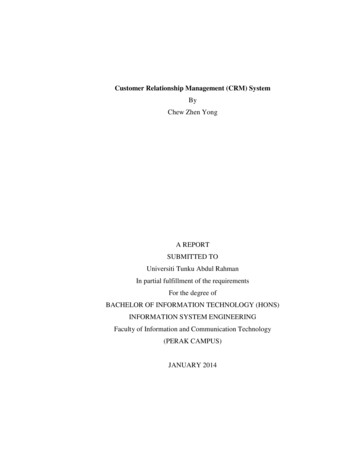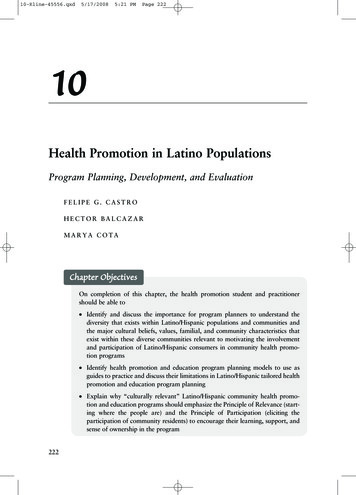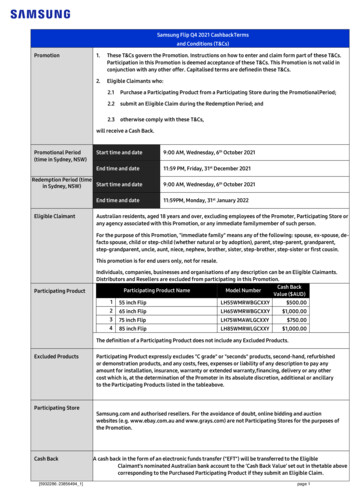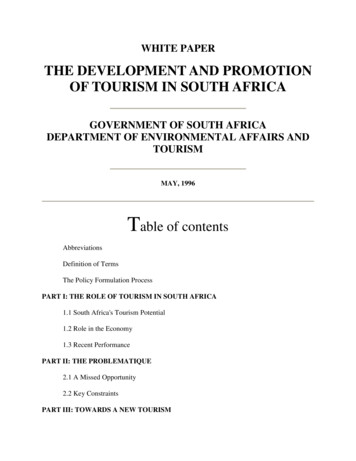
Transcription
WHITE PAPERTHE DEVELOPMENT AND PROMOTIONOF TOURISM IN SOUTH AFRICAGOVERNMENT OF SOUTH AFRICADEPARTMENT OF ENVIRONMENTAL AFFAIRS ANDTOURISMMAY, 1996Table of contentsAbbreviationsDefinition of TermsThe Policy Formulation ProcessPART I: THE ROLE OF TOURISM IN SOUTH AFRICA1.1 South Africa's Tourism Potential1.2 Role in the Economy1.3 Recent PerformancePART II: THE PROBLEMATIQUE2.1 A Missed Opportunity2.2 Key ConstraintsPART III: TOWARDS A NEW TOURISM
3.1 Tourism and the RDP3.2 Why Tourism?3.3 Any Kind of Tourism?3.4 Responsible Tourism3.5 Effects of Irresponsible TourismPART IV VISION, OBJECTIVES AND PRINCIPLES4.1 Vision4.2 Guiding Principles4.3 Critical Success Factors4.4 Key Objectives4.5 Specific TargetsPART V: IGNITING THE ENGINE OF TOURISM GROWTH5.1 Safety and Security5.2 Education and Training5.3 Financing Tourism5.4 Investment Incentives5.5 Foreign Investment5.6 Environmental Conservation5.7 Cultural Resource Management5.8 Product Development5.9 Transportation5.10 Infrastructure5.11 Marketing and Promotion
5.12 Product Quality and Standards5.13 Regional Cooperation5.14 Youth DevelopmentPART VI: ROLES OF THE KEY PLAYERS6.1 Role of the National Government6.2 Role of the Provincial Government6.3 Role of Local Government6.4 Role of the Private Sector6.5 Role of Labour6.6 Role of Communities6.7 Role of Women6.8 Role of NGOs6.9 Role of the Media6.10 Role of Conservation AgenciesPART VII ORGANISATIONAL STRUCTURE7.1 Ministry of Environmental Affairs and Tourism7.1.1 Department of Environmental Affairs and Tourism7.2 National Tourism Organisation7.2.1 Responsibilities of National Tourism Organisation7.2.2 Representation and Reporting Relationships7.2.3 Committees of the Board7.2.4 Establishment of the National Tourism Organisation7.3 Provincial Tourism Organisations
7.4 The Way ForwardAbbreviationsCBOCommunity-based OrganisationDTIDepartment of Trade and IndustryEUEuropean UnionFITForeign Independent TouristsGDPGross Domestic ProductGEMGroup for Environmental MonitoringIPTCInter Provincial Technical CommitteeITTTInterim Tourism Task TeamCommittee of Members of Executive Councils responsible for tourism in theMINMEC provinces and the Minister and Deputy-Minister of Environmental Affairs andTourism in the central governmentNGONon-governmental OrganisationRDPReconstruction and Development ProgrammeRETOSARegional Tourism Organisation of Southern AfricaSADCSouthern African Development CommunitySATOUR South African Tourism BoardSMMEsSmall, Micro and Medium-sized EnterprisesUSPUnique Selling PointVFRVisitors to Friends and RelativesDefinition of TermsCultural tourismcultural aspects which are of interest to the visitor and can bemarketed as such, including the customs and traditions of people,
EcotourismEmerging marketsEmergent SMMEsEnvironmentInternational touristPreviously neglectedcommunitiesResponsible tourismtheir heritage, history and way of life.environmentally and socially responsible travel to natural or nearnatural areas that promotes conservation, has low visitor impact andprovides for beneficially active socio-economic involvement of localpeoplepopulation groups entering the market in increasing numbers asdomestic tourists, especially those previously neglected.small, micro and medium-sized enterprises owned and/or operatedby the previously neglected population groups that are entering themarketincludes natural, urban, human living and cultural environmentsa person who travels to a country other than that in which she/he hasher/his usual residence, but outside her/his usual environment, for atleast one night but less than one year, and the main purpose of whosevisit is other than the exercise of an activity remunerated from withinthe country visited. Due to markedly different travel and expenditurepatterns, a distinction is drawn between international tourists fromthe rest of Africa (called regional tourists) and those from othercountries (called overseas tourists). See definition of tourist.population groups that were largely excluded from mainstreamtourism activities.tourism that promotes responsibility to the environment through itssustainable use; responsibility to involve local communities in thetourism industry; responsibility for the safety and security of visitorsand responsible government, employees, employers, unions and localcommunitiesStatutoryan organisation established by an Act of GovernmentOrganisation/parastatala person who travels away from home for other than commutingStop-over visitorpurposes, staying less than 24 hours in the place visiteddevelopment tourism development, management and any othertourism activity which optimise the economic and other societalSustainable tourismbenefits available in the present without jeopardising the potentialfor similar benefits in the futureall recipients of direct spend incurred by tourists. This includes pretrip expenditure on travel and booking, travel and en-routeThe tourism industryexpenditure, and all spending at the destinationa person who travels away from home, staying away for at least onenight. A tourist can be a domestic tourist (for example resident ofJohannesburg staying one night in Durban), a regional tourist ( avisitor from Zimbabwe spending one or more nights in the FreeTouristState) or an overseas tourist (a resident of Germany staying one ormore nights in the North-West Province). See definition ofinternational tourist. A tourist travels for different purposes including
TourismTraditional domesticmarketsbusiness, leisure, conference and incentive.all travel for whatever purpose, that results in one or more nightsbeing spent away from homepreviously advantaged domestic leisure touristsThe policy formulation processIn October 1994, the Minister of Environmental Affairs and Tourism appointed the InterimTourism Task Team (ITTT) with the mandate of drafting a tourism discussion paper as a basisfor a future national tourism policy. Representing the business sector, labour movement,provincial governments, community organisations and the national government, the ITTTproduced a Tourism Green Paper in September 1995. The Tourism Green Paper was widelydistributed for comment, whereafter the European Union was approached to provide technicalassistance to the Government of South Africa in developing a Tourism White Paper. Aninternational tourism specialists was appointed by the European Union for this purpose, inOctober 1995. It was recognised that the process of arriving at a White Paper for tourism is asimportant as the White Paper itself. As such, a great deal of emphasis was placed on developingthe White Paper in such a way as to facilitate maximum participation by all. To this end, theprocess involved a number of research methods and strategies as follows:1. A number of ITTT meetings were held to monitor progress and provide comments on theprocess followed and the content of the document.2. Ten workshops were held country-wide to discuss the Green Paper and obtain inputs forthe White Paper. More than 500 persons participated in these country-wide workshops.3. Nearly 100 expert interviews and one-on-one consultations were carried out with keystakeholders in the industry.4. More than 100 written submissions were received and reviewed.5. A number of strategic meetings were attended, including meetings of MINMEC, IPTC,Hotel Industry Liaison Group, the Strategic Tourism Security Workshop, MuseumWorkshop and the national tourism workshop held on 4 March 1996.6. Local consultants were appointed by the lead consultant to assist in carrying outsecondary research and analysis of the tourism industry as well as the development ofstrategies and implementation programmes.7. The consultants drew upon a number of reports by SATOUR and other organisations,White Papers of other government departments and other relevant documents.The White Paper provides a policy framework and guidelines for tourism development in SouthAfrica. It will be followed by an implementation strategy which will contain a number of keyactions in order to effectively implement the guidelines contained in the White Paper
PART I: ROLE OF TOURISM IN SOUTH AFRICA1.1 Tourism potentialWith a population of approximately 41 million and a land area of 1.27 million sq. km (nearlyfive times the size of the UK), South Africa's resource base for tourism is phenomenal. Thecountry's tourism attractiveness lies in its diversity. Some of the features which make SouthAfrica an incredibly attractive tourism proposition include: accessible wildlife, varied andimpressive scenery, unspoiled wilderness areas, diverse cultures (in particular traditional andtownship African cultures), generally sunny and hot climate, no 'jet lag' from Europe, a welldeveloped infrastructure and virtually unlimited opportunities for special interest activities suchas whale-watching, wild water rafting, hiking, bird-watching, bush survival, deep-sea fishing,hunting and diving. In addition, unique archaeological sites and battlefields, the availability ofexcellent conference and exhibition facilities, a wide range of sporting facilities, goodcommunication and medical services, internationally known attractions (Table Mountain, Capeof Good Hope, Sun City, Kruger National Park, Garden Route, Maputaland) and unrivaledopportunities to visit other regional internationally known attractions (e.g. Victoria Falls and theOkavango Swamps) make South Africa an almost complete tourist destination.Tourism has become a fiercely competitive business. For tourism destinations the world over, asindeed for South Africa, competitive advantage is no longer natural, but increasingly man-made- driven by science, technology, information and innovation. As such, it is not simply the stockof natural resources of South Africa that will determine her competitiveness in tourism, butrather, how these resources are managed and to what extent they are complemented with manmade innovations. In this regard, South Africa scores well on three important fronts. First, thealready well-established network of national parks (covering some 6.3% of the surface area ofthe country) and private nature reserves are very much 'on trend' with the demands of theincreasingly environmentally sensitive visitor. Second, some companies are already leaders inglobal 'best practice' in ecotourism, while others have created Disneyland-like attractions inSouth Africa, boosting the country's name internationally. Third, the recent successful politicaltransformation in South Africa has virtually 'opened' the country's tourism potential to the rest ofthe world and indeed to the previously neglected groups in society. It is not surprising that theWorld Tourism Organisation in its 1995 review of African tourism considers South Africa to be"one of the most promising tourism destinations of the African continent". The Horwath 1995Worldwide Hotel Industry Review concluded that South Africa's tourism potential "isoutstanding, providing peace and harmony remain".Notwithstanding all the abovementioned advantages, South Africa has not been able to realise itsfull potential in tourism. As such, the contribution of tourism to employment, small businessdevelopment, income and foreign exchange earnings remains limited.1.2 Role in the economyTourism currently plays a relatively small role in the economy of South Africa. The EconomistIntelligence Unit estimates the value added of tourism in South Africa to be no more than 2% of
Gross Domestic Product (GDP) in 1994. Kessel Feinstein and SATOUR estimate that in 1995,tourism's contribution to GDP was in the vicinity of 4%, which is very low by any standard. TheWorld Travel and Tourism Council estimated that in 1995, tourism contributed 10.9% to theGDP of the world economy; 10.5% to the US economy; 13.4% to the European economy; 12.3%to the British economy and 31.5% to the Caribbean economy. SATOUR estimates that 480,000jobs are directly and indirectly created by tourism. Tourism is the fourth largest earner of foreignexchange in South Africa.The potential for South Africa to grow its tourism industry, to triple its contribution to nationalincome and to at least double its foreign exchange earnings by the year 2000, is very real. Ifcontributed 10% to the GDP of South Africa, as it does in the US, the industry would generatesome R40b annually and create 2 million jobs.1.3 Recent performanceIn 1995, South Africa received 4.48 million international visitors. Africa continues to generatethe bulk of international arrivals to South Africa (73%) with Europe accounting for about 15%.North and South America, the Middle East, Australasia and the Indian Ocean Islands continue tobe very marginal contributors, together accounting for not more than 12% of total internationalarrivals. In 1995, South Africa received just under 1,1 million overseas visitors (originating fromoutside Africa). In addition it is estimated that there are some 7.9 million domestic tourists whotook a total of 17 million holidays in 1994. The potential for South Africa to increase botharrivals and expenditures from all three markets -overseas, regional and domestic - is substantial,considering that the majority of the previously neglected groups in society have not traveled andthat the neighbouring African markets have good potential for further development.Domestic tourism plays a specially important role in the South African tourism industry. Thismarket will continue to grow as previously neglected people become tourists and travelersthemselves. International tourism is also a vital element of the South African tourism industry overseas and Africa air arrival visitors spend an average of R14,000 (including airfare). TheReserve Bank conservatively estimates that African land arrival visitors spend on average R600when they visit South Africa. Within the international tourism market, the business travelmarket, the conference, incentive and leisure segments are of critical importance to the SouthAfrican tourism industry. Following the democratic elections of April 1994, extremely positivegrowth in visitor arrivals from both the regional and overseas markets was recorded. Overseasvisitors to South Africa are expected to double by the year 2000.While there is no doubt that growth will continue under the pressure of regional and overseasdemand, there is no guarantee that growth will be sustainable, or that the tourism industry will befully able to act as an engine of growth for the economy, or achieve the socio-economicobjectives set by the new Government. Key actions, policies and strategies are necessary toensure that South Africa realises its tourism potential as well as avoid the mistakes that otherdestinations have made.
PART 2: THE PROBLEMATIQUE2.1 A missed opportunityTourism development in South Africa has largely been a missed opportunity. Had its historybeen different, South Africa would probably have been one of the most visited places in theworld. The tourism industry in South Africa has been woefully protected - protected fromforeign competition (limited international investment in tourism facilities), protected fromdemanding, long-stay tourists (limited flow of international visitors) and protected from itself(suppliers cater to a largely homogeneous and predictable clientele, i.e. the easily identifiableneeds of the privileged class). As such, the potential of the tourism industry to spawnentrepreneurship, to create new services (e.g. local entertainment, handicrafts, etc.), to "drive"other sectors of the economy, to strengthen rural communities, to generate foreign exchange andto create employment, has not been realised.Yet tourism, perhaps more than any other sector, has the potential to achieve the objectives of theReconstruction and Development Programme (RDP) of the new government. Tourism createsopportunities for the small entrepreneur; promotes awareness and understanding among differentcultures; breeds a unique informal sector; helps to save the environment; creates economiclinkages with agriculture, light manufacturing and curios (art, craft, souvenirs); creates linkageswith the services sector (health and beauty, entertainment, banking and insurance); and providesdignified employment opportunities. Tourism can also play a strategic role in dynamising othersectors of the economy - the agriculture sector that benefits from the tourism industry (increaseddemand for new agricultural products and services such as organic agriculture, farm tourism); themanufacturing sector (the supply of furniture and fittings, construction, linens, pots, pans, etc.) aswell as crafts (wood-working, curios, fine art). Perhaps the weakest economic linkages with thetourism industry in South Africa exist in the services sector (entertainment, health and beautyservices, banking, insurance).Many international tourism destinations have successfully used the tourism industry toencourage other sectors of the economy and to generate new and innovative employmentopportunities. In Jamaica, for example, Jamaicans teach tourists to speak Jamaican and dancereggae; in Barbados, one of the most profitable activities - hair-braiding - takes place in theinformal sector; in a Budapest hotel a dental check-up is included in the price of the room; andlocal live entertainment is the norm at most hotels in the world - from Berlin and Boston to theBahamas.The tourism industry in South Africa has been, and continues to be, faced with a number ofimpediments to its further growth and development. Key constraints facing the industry as wellas immediate problems are identified below.2.2 Key constraintsA number of factors limit the effectiveness of the tourism industry to play a more meaningfulrole in the national economy. Some of the key constraints are identified below:
tourism has been inadequately resourced and fundedmyopic private sectorlimited integration of local communities and previously neglected groups into tourisminadequate tourism education, training and awarenessinadequate protection of the environmentpoor servicelack of infrastructure, particularly in rural areasa ground transportation sector not geared to service touristslack of inclusive, effective national, provincial and local structures for the development,management and promotion of the tourism sectorIn addition to these constraints, an immediate problem facing the industry is the growing levelsof crime and violence on visitorsThese are explained below:i.Inadequately resourced and funded tourism industryOne of the problems facing the tourism industry is that the Government has had a limitedview of the potential of the industry and, as a result marginal resources have beendevoted to developing and promoting the sector. Tourism is still narrowly viewed astourists and hotels. In many quarters, the tourism industry is still seen as a thing of thepast - a plaything for the previously privileged class. The true wealth-creating potential ofthe sector has not been fully grasped by policy-makers (refer to Section 3.3 - WhyTourism). Unless tourism is seen as strategically important to the economy of SouthAfrica and the necessary plans, policies, actions and resources to support this initiativeare put in place, tourism will continue to be a missed opportunity.ii.Myopic private sectorAnother major problem facing the South African tourism industry is a short sightedprivate sector. Hotels, and indeed many other tourism establishments, tend to have arather limited view of the product they offer - only goods and services within their fourwalls. If a visitor is harassed on the road; over-charged by a taxi driver; the environmentdestroyed by insensitive development; or schools are dilapidated , it is not considered thehotel's concern. Experience indicate that hotels that have taken a much broader view oftheir product tended to be more successful:ooCurtin Bluff Hotel in Antigua has virtually adopted its surrounding community.Locals from the village, for example, are provided with opportunities to becometennis pros and many are sent abroad for training.Half Moon Hotel in Jamaica has adopted half a mile of highway surrounding itshotel and is committed to maintaining and beautifying it. The hotel is also in theforefront of environmental conservation.
oHotels in St. Lucia in the Caribbean have pioneered an 'adopt a farmer'programme. The advanced orders that hotels place provide farmers with thenecessary collateral for them to obtain bank loans to invest in production.In South Africa, signs of a more forward-looking private sector are emerging. Variousecotourism companies and conservation agencies are increasingly promoting meaningfulcommunity participation and shareholding in tourism ventures. These initiatives are,however, still the exception and hotels and other tourism establishments need to play afar more active role in influencing the quality of the total visitor experience. It is throughtaking a broader view of the product offered, and building partnerships with thegovernment, local communities and other private sector interests, that the highest levelsof customer satisfaction can be achieved.iii.Limited development scope due to past political policiesThe past apartheid policies have placed severe constraints on the development scope ofthe industry. While the attractiveness of South Africa as a tourism destination has alwaysbeen acknowledged, this potential could not effectively be realised due to many touristsnot wanting to travel to country in protest to such policies. The current growth of theindustry could largely be ascribed to the political changes of the past few years and theresultant freedom of movement.iv.Limited involvement of local communitiesAnother major problem facing the South African tourism industry is the poorinvolvement of local communities and previously neglected groups in the industry. Whilethis has been largely due to the previous Government's policies, the need to reverse thissituation is of urgent importance. The tourism industry, perhaps more than any sector,provides a number of unique opportunities for involving previously neglected groups,including:Operators of tourism infrastructure:oooooooSmall guest houses or bed and breakfast establishmentsTaverns, shebeens, bars and restaurantsTransport - taxi services, tours, trips, airport and other transfersAttractions - township experiences, apartheid and struggle historyMuseums - traditional culture and historyEntertainment - music, dance, theatre, story-telling, etc.Other - florists, art galleries, hair salons, beauty parlours, craft shopsServices to the industryoooTour operator servicesTravel agenciesTour guides
oooMarketing servicesBooking servicesTraining servicesSuppliers to the industryoooooooooLaundry services -ironing only, full laundry, sewing and repairsPortering servicesProduction and selling of craftsInterior decor - rugs, wall hangings, furniture, textiles, artConstruction - collection of materials, thatching, building tradesMaintenance services - vehicles, plant and equipmentEnvironmental services - gardening, bush clearing, compostingSpecialty agriculture - herbs, organically grown produceSpecialty tourism products - traditional hunting, traditional medicines and herbsDespite these obvious and available opportunities, however, many factors limit themeaningful involvement of local communities in the tourism industry. These include:w.lack of information and awareness;x. lack of know-how and training;y. lack of finance;z. lack of interest on the part of existing establishments to build partnerships withlocal communities and suppliers; andaa. lack of incentives to reward private enterprise that build or develop local capacityand create job opportunities.The concerns and anxieties of the previously neglected groups need to be understood andadequately addressed in building a successful tourism industry in South Africa. Some ofthese concerns are:ooooo"Tourism is a white man's thing and not for us" - tourism is perceived ascatering to the predominantly white upper and middle classes. There is a beliefthat "tourism is what whites do when they go to Kruger Park or the beach inDurban", and certainly not within the reach of the previously neglected.The majority of South Africans have never been meaningfully exposed to thetourism industry and have not benefited from the country's vast resources.Suspicion and mistrust - most protected areas were proclaimed withoutconsultation with, or the approval of, affected rural communities. Communitiesbore the cost of reduced access to natural and cultural resources but did notperceive, or receive any direct benefits.Complete lack of knowledge and understanding of what tourism really is there is a perception that tourism refers only to people traveling around andstaying in hotels. The wider opportunities offered by tourism are not appreciated.Lack of training opportunities for previously neglected groups in societyeffectively limits meaningful participation in the tourism industry.
oooooooInability to access finance to take advantage of entrepreneurial opportunitiesprovided by the tourism sector.Lack of involvement - the majority of South Africans have not been involved inthe planning, decision-making, investment, development or promotion of thetourism industry. Communities have not been involved or consulted in respect ofmajor investment decisions or developments proposed for areas in which theylive.Inequalities - past inequalities and abuse of power have led to the exploitation oflocal cultures and community groups.Language barriers - the English language seems to be the established languageof tourism communication, effectively excluding a majority of the population ofSouth Africa where 11 official languages are in vogue.Negative attitudes - negative attitudes exist within the industry towardscommunity tourism products which are sometimes viewed with skepticism andregarded as inferior. There is often a view that what is white and Western is best.The value of the previously neglected people, their culture and their productsoften tend to be depreciated.Lack of market access - local communities lack access to the lucrative tourismmarkets as visitors are kept within the hotels and resorts and venture out only to'sanitised' places of interest. For the local shebeens or the local craft vendor, avisitor sighting is a rare occasion.Barriers to entry - these are caused by very large companies and corporatestructures which control the market. Businesses in South Africa are either verylarge or very small - a middle segment is only slowly emerging. The cost ofcapital furthermore prevents many small operators from entering the market.A great deal of work has to be done by both the government and tourism private sector toredress previous imbalances, to win back the support of the previously neglected groupsand to demonstrate that tourism in the new South Africa can benefit all South Africans.To succeed, any tourism development policy of South Africa must, as a priority, seek themeaningful involvement of the previously neglected communities, not only in the supplyof their labour services, but also in entrepreneurial activities. As will be demonstrated inSection 3, responsible tourism is not a luxury for South Africa, but an absolute necessityif the country has to build a successful and sustainable tourism industry.v.Inadequate training, education and awarenessPerhaps the greatest deficiency in the tourism industry in South Africa is the absence ofadequate education, training and awareness opportunities. The previously neglectedgroups in society are highly disadvantaged and the job of leveling the playing field is amassive one. One of the key vehicles for doing so is education and training - a basicnecessity that the majority of the population has not had access to.The tourism industry in South Africa directly and indirectly employs an estimated480,000 persons, a figure which is expected to double by the year 2000. At the tertiary
level, training in tourism and hospitality services is offered at a limited number of publicand private institutions. Skills training at the lowest levels (e.g. barmen, cleaners, porters)is mainly done on an in-house basis.With a total training capacity of some 10,000 and an industry expected to require 100,000additional persons per year in the next five years, training capacity falls far short of theneeds. This is not to mention the general need for community-wide tourism awarenessprogrammes as well as the urgent need for a wide range of basic skills among personswho are the first line of contact with the customer. The data suggest that South Africa isnot capable with present output to satisfy more than 10% of its training needs.It is important to note also that training capacity, what little there is, is very unevenlyspread among the provinces, with Gauteng, North-West and the Western Cape Provinceleading the field. Northern Cape in particular, and to a lesser degree the NorthernProvince, and Mpumalanga, have little to show in terms of facilities. The discrepanciesbecome more marked as one moves to institutions of higher learning such as universitiesand technikons.vi.Inadequate environmental managementEnvironmentally, South Africa is an incredibly unique and rich country. The World WideFund for Nature: South Africa estimates that South Africa is the third most biodiversecountry in the world, has one third of the plant species in the world and 8% of the world'splants. The country has a well-maintained network of protected areas and is globallyrenowned for its conservation practices. However, despite this excellent record inconservation, South Africa is also one of the environmental "hot spots" in the world with2,000 plant species on the endangered list.Some of the main environmental problems and issues have been identified by Grossmanand Associates in their 1996 report:oooooUnequal land distri
PART IV VISION, OBJECTIVES AND PRINCIPLES 4.1 Vision 4.2 Guiding Principles 4.3 Critical Success Factors 4.4 Key Objectives 4.5 Specific Targets PART V: IGNITING THE ENGINE OF TOURISM GROWTH 5.1 Safety and Security 5.2 Education and Training 5.3 Financing Tourism 5.4 Investment Incentives 5.5 Foreign Investment 5.6 Environmental Conservation




